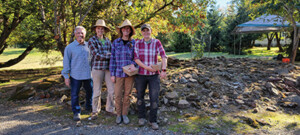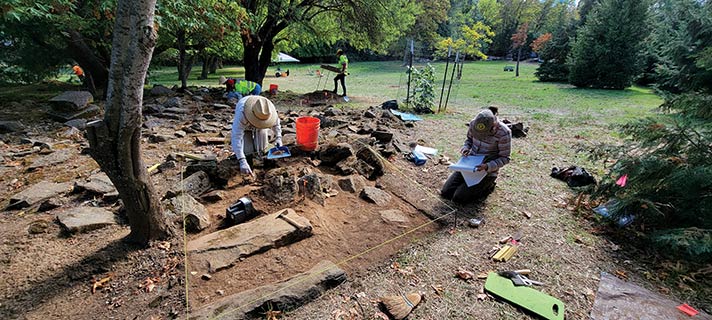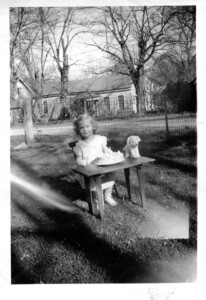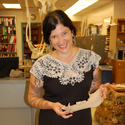Digging Jacksonville – December 2021/January 2022
When archaeologist Chelsea Rose invited me to help the Southern Oregon University Laboratory of Anthropology (SOULA) team of archaeologists survey the Eagle Brewery property on South Oregon Street, I jumped at the chance. I’ve been volunteering with SOULA for over a decade now, but this place is special to me. Chelsea and Tiah Edmondson-Morton, an archivist from Oregon State University, were very interested in the history of the brewery site. Tia is finishing a book about women brewers in Oregon. Apparently, Frederica Wetterer ran the Eagle Brewery for a time in the 19th century. The microbrewery was established during the gold rush (one of the first in the region and state), and although improvements were made to the property over time, it remained largely undeveloped. The current property owners, Ken Gregg and Frank De Luca, wisely chose to have an archeological survey done in advance of the future development on the 2+ acre parcel.

Homeowner Frank De Luca with archaeologists from the Rogue River-Siskiyou National Forest who volunteered to help with the project.
But as the historians and archaeologists marveled as the clues to the brewery activity emerged, I was transported to my youth. The site of the brewery is across the street from where I grew up on Oregon Street. I spent the first decade of my life playing on the property. Mary and Joseph Wetterer, unmarried elderly siblings who lived their entire lives on the property, were still alive when I was a child, and I have vague memories of elderly people dressed in black. Their home, spooky and unkempt after their deaths, would be torn down a few years later. My grandparents, who also lived across the street and were friends of Mary and Joe, inherited much of the contents of the home and the foundation stones. The saloon building in front of the brewery was a rental home, probably from the time the brewery closed. It had a series of renters, none of whom stayed long. Families often had children my age and we had varying degrees of freedom on the property.
Behind the home and saloon were perils: there was the vegetation-covered rock pile that has now been removed to reveal the site of a small building, a large empty basement (the original brewery cellar) directly behind the home that was filled with debris, bricks, junk, and blackberries, and of course the basement of the saloon/house which was strictly off-limits. The open field to the south was an abandoned vineyard. The field’s remaining elderly vines were allowed to grow in freeform. When the grass grew tall in June and the grape leaves emerged, each vine provided a perfect space for a little home. A free range kid would choose a vine and decorate it with boxes and blankets and trinkets. The older children would make up stories to terrify those younger and gullible. Of course there were dragons living in that basement and in that bottomless hole filled with junk. Watch out for monsters and bad guys with guns! And ghosts! We would play until dark until one of the mothers would call us home. My brother built a tree house at the front of the property and no one asked him for his permit. The saloon had a porch of sorts and because it was near the street it became the gathering and staging area for go-cart races, endless marbles competitions and forays into the Diggings or the Britt Woods. When the foundation stones of the Wetterer home were removed, my brother and I were old enough to appreciate the treasures that had slipped under the house between the stones, but we gave little thought to history or archaeology at the time. We moved a few blocks away and Eugene Bennett rescued the property. The monsters and dragons moved, too. The vineyard gradually disappeared. Today finds the large parcel carefully tended with history preserved. This kid got to play amongst the past one more time.


 Chelsea Rose is an historical archaeologist who specializes in the settlement and development of the American West. Chelsea and the Southern Oregon University Laboratory of Anthropology (SOULA) conduct archaeology across Oregon and have done several projects in Jacksonville. You can reach Chelsea at rosec@sou.edu and follow SOULA on
Chelsea Rose is an historical archaeologist who specializes in the settlement and development of the American West. Chelsea and the Southern Oregon University Laboratory of Anthropology (SOULA) conduct archaeology across Oregon and have done several projects in Jacksonville. You can reach Chelsea at rosec@sou.edu and follow SOULA on